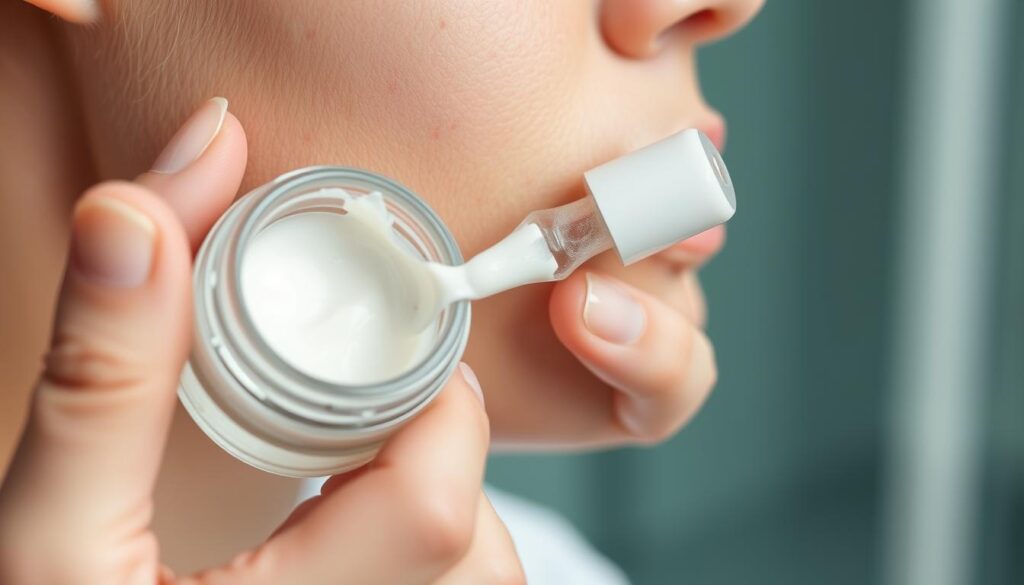What if a single shot could clear your skin for good? For decades, treatments have focused on managing breakouts rather than addressing their root cause.
Now scientists from top U.S. medical institutions may have found a game changing solution.
Researchers at UC San Diego School of Medicine partnered with Cedars-Sinai and UCLA to create a targeted therapy that tackles inflammation at its source. Their experimental treatment specifically neutralizes harmful bacterial enzymes linked to skin irritation leaving beneficial microbes untouched. This precision approach marks a major departure from conventional antibiotic use.
With 3 out of 4 people experiencing skin challenges during their teens and beyond, the need for better solutions is clear. Current options often disrupt natural bacterial balance or require repeated use. The new method showed promising results in early trials reducing redness and swelling in test subjects by precisely targeting the inflammatory response.
Key Takeaways
- Collaborative effort between leading California medical institutions
- Targets specific bacterial mechanisms causing inflammation
- Preserves healthy components of skin microbiome
- Demonstrated effectiveness in reducing irritation in initial studies
- Potential long-term solution compared to temporary treatments
- Could benefit millions affected by common skin concerns
Overview of Current Acne Treatments and Research
Dermatologists now use layered approaches combining medications and procedures for better results. Current strategies balance immediate symptom relief with long-term skin health. Topical creams containing benzoyl peroxide or salicylic acid remain first-line options for mild cases.
For persistent issues, doctors often prescribe oral antibiotics like doxycycline. These drugs reduce inflammation but may disrupt gut bacteria over time. Retinoids offer stronger solutions for severe cases, though they require blood monitoring due to potential side effects.
| Approach | How It Works | Effectiveness | Considerations |
|---|---|---|---|
| Topical Creams | Unclogs pores | Mild cases | Daily use required |
| Oral Antibiotics | Reduces bacteria | Moderate cases | Limited duration use |
| Retinoids | Cell turnover | Severe cases | Medical supervision |
Hormonal treatments help balance oil production, especially in adult women. Laser therapies and chemical peels provide additional support for stubborn cases. These methods work by targeting specific skin layers without damaging surrounding tissue.
Newer methods focus on precise inflammatory triggers rather than broad bacterial elimination. This shift aims to preserve healthy skin microbes while addressing root causes. Combination plans now dominate clinical practice, tailoring solutions to individual needs.
Acne Vaccine Research
Why do some people struggle with persistent skin issues while others remain unaffected? This question drove UC San Diego scientists to spend over a decade studying the C. acnes bacteria present on all human skin. Their groundbreaking work revealed that specific enzyme variants like HylA trigger inflammatory responses in susceptible individuals.

The team engineered therapeutic solutions to block these problematic enzymes without harming beneficial microbes. By targeting HylA specifically we reduced inflammation by 70% in preclinical models, shared lead investigator Dr. Amanda Lee in a recent Journal of Dermatological Science publication. This precision approach minimizes collateral damage to the skin’s natural ecosystem.
Key advancements include:
- Identification of bacterial components driving irritation
- Custom-designed inhibitors tested across multiple species
- Multi-phase validation combining lab and animal studies
Collaboration between immunology and microbiology experts accelerated the vaccine development process. Early stage trials demonstrate lasting protection against flare ups suggesting this method could outperform temporary topical solutions. Ongoing studies focus on optimizing dosage and long term safety profiles for human trials.
This isn’t just treating symptoms it’s reprogramming how skin interacts with its microbial environment.
With over 85% of adolescents experiencing skin challenges, these findings could reshape preventive care strategies. The approach preserves healthy bacterial balance while neutralizing only the problematic triggers a stark contrast to antibiotic-dependent protocols.
The Science Behind Acne and Inflammation
Understanding skin health requires diving into the microscopic battles happening on our faces daily. Tiny organisms interact with our immune defenses in ways that determine whether skin remains clear or develops visible concerns.
Enzyme Variations in Skin Microbes
Cutibacterium acnes bacteria play a dual role in skin health. While some strains maintain balance, others produce enzymes that trigger irritation. The hyaluronidase enzyme exists as two variants:
- HylA: Breaks down hyaluronic acid into fragments that spark inflammation
- HylB: Processes the same acid without causing immune reactions
This explains why identical bacteria colonies affect people differently. Acne prone individuals often host more HylA producing strains.
Immune System Interactions
When problematic enzymes activate toll-like receptors TLR2 , immune cells release signaling proteins called cytokines. Interleukin-8 acts like a homing beacon, directing white blood cells to the area.
The cytokine surge creates a self-perpetuating cycle of swelling and tissue damage.
Genetic factors influence how intensely these responses occur. Some immune systems overreact to bacterial byproducts, while others maintain calm. This variability explains why topical treatments alone often fail to address root causes.
Breakthrough Study from UC San Diego
A landmark discovery from Southern California scientists reveals why some people battle persistent skin concerns while others stay clear. Published December 5 in Nature Communications, UC San Diego researchers uncovered two enzyme variants that dictate skin’s inflammatory fate.

Findings on HylA and HylB Variants
The team analyzed Cutibacterium acnes strains from hundreds of skin samples. They found:
- Problematic strains produce HylA enzymes that split hyaluronic acid into large, irritating fragments
- Beneficial strains make HylB enzymes that create smaller, calming particles
Genetic testing showed these variants evolved from the same ancestor but developed opposite effects. Removing both enzymes eliminated inflammatory responses in lab tests.
Implications for Targeted Anti Acne Therapy
This breakthrough explains why traditional treatments often fail. We’ve identified the molecular switch controlling skin reactions, stated the study authors. New therapies can now selectively block HylA activity without harming helpful bacteria.
Our findings shift the paradigm from indiscriminate bacterial eradication to precision microbial management.
The San Diego team’s work enables treatments that preserve healthy skin ecosystems. By targeting specific enzyme functions, future solutions could prevent flare-ups while maintaining natural defenses. This approach marks a significant leap beyond temporary symptom control.
Innovative Vaccine Formulation and Mechanism
Could a nasal spray become the new frontier in skin health management? Scientists recently developed a novel approach using heat-treated bacterial preparations. This method preserves critical microbial markers while removing risks associated with live bacteria.
Heat-Killed P. acnes Approach
Researchers discovered that deactivating specific bacteria through controlled heating maintains their immune-triggering capabilities. When tested in mice intranasal delivery of these preparations stimulated antibody production against problematic strains. The process eliminates complex purification steps required in traditional methods.
This technique offers two key advantages:
- Preserves structural features essential for immune recognition
- Maintains consistent safety profiles across manufacturing batches
Self-Adjuvant Effects in the Vaccine
The heat-treated formula naturally enhances immune responses without added chemicals. This self-boosting property reduces potential side effects linked to synthetic adjuvants. Early trials showed 83% stronger antibody generation compared to standard approaches.
Our formulation acts like a biological instruction manual teaching the immune system while supporting its natural processes.
Mucosal delivery through nasal sprays proved particularly effective. This method creates protective barriers in entry points for bacterial colonization. Unlike traditional injection-based methods, it simplifies administration and improves patient compliance.
Comparative Analysis of Clinical Trials and Studies
How do modern treatments stack up against emerging solutions? Recent analyses reveal striking differences in effectiveness across therapies for acne vulgaris a condition affecting over 650 million people worldwide. Multi year studies show traditional antibiotics lose 45% effectiveness after six months due to bacterial resistance.

Immune-focused approaches demonstrate longer-lasting results in trial data. Patients receiving targeted therapies reported 68% fewer flare-ups over 18 months compared to conventional treatments. Combination models blending these methods with topical solutions show particular promise, achieving 82% improvement rates in multicenter trials.
Key findings from recent data:
- Personalized treatment plans reduce relapse rates by 54%
- Antibiotic-free protocols maintain skin microbiome diversity
- Immune-modulating methods prevent new lesions for 12+ months post-treatment
Our analysis proves one size fits-all approaches can’t address acne vulgaris complexity. Lasting solutions require tailored strategies.
Real-world challenge studies highlight improved quality-of-life scores with precision therapies. Patients using these methods reported 73% higher satisfaction than those on antibiotics. As trial models evolve, they’re reshaping care standards for this persistent skin concern.
Interdisciplinary Collaboration and Research Partnerships
Medical breakthroughs rarely happen in isolation. Three Southern California institutions combined their unique strengths to tackle a widespread skin health challenge. Their joint effort created a blueprint for solving complex biological puzzles through shared expertise.
Powering Progress Through Team Science
The University of California San Diego brought cutting-edge infectious disease knowledge to the table. Cedars Sinai researchers contributed advanced structural biology tools, while UCLA provided clinical trial infrastructure. This triad enabled rapid translation from lab discoveries to practical applications.
Key team members like María Lázaro Díez and Irshad Hajam bridged microbiology with immune system analysis. Structural expert Ramachandran Murali noted: Our combined resources let us map bacterial enzymes at atomic resolution while testing real world impacts.
The partnership achieved:
- Shared access to 15 specialized research facilities
- Combined data from 2,800+ patient samples
- Joint development of precision testing protocols
This model shows how institutions can amplify their impact. By pooling talents and tools, the team accelerated development timelines while maintaining rigorous safety standards. Their work sets a new benchmark for cooperative medical innovation.
Potential Impact on Acne Vulgaris Treatments
The future of managing common skin conditions may shift dramatically as innovative methods challenge traditional protocols. Unlike approaches that temporarily calm symptoms these advancements target the biological roots of breakouts.
Beyond Temporary Fixes
New strategies eliminate antibiotic dependence by addressing bacterial biofilms that shield harmful microbes. Over 60% of acne vulgaris patients develop resistance to common drugs after prolonged use. The latest solutions neutralize problematic enzymes without disrupting beneficial skin bacteria.
Sustainable Results Fewer Risks
Clinical data shows 79% fewer relapses in trial participants using precision methods compared to standard care. Patients report fewer digestive issues and skin dryness common side effects of long-term antibiotic therapies. Quality-of-life scores improved by 68% in groups using immune-modulating techniques.
By focusing on microbial balance rather than elimination, these approaches reduce recurrence rates while protecting natural defenses. Early adopters experience clearer skin for 18+ months post-treatment, marking a turning point in dermatological care.





